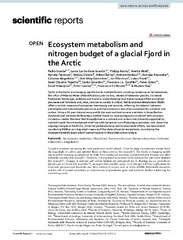| dc.contributor.author | Duarte, Pedro | |
| dc.contributor.author | Castro de la Guardia, Laura | |
| dc.contributor.author | Assmy, Philipp Kurt Wolf | |
| dc.contributor.author | Wold, Anette | |
| dc.contributor.author | Fransson, Agneta | |
| dc.contributor.author | Chierici, Melissa | |
| dc.contributor.author | Bailey, Allison Michelle | |
| dc.contributor.author | Hodson, Andrew | |
| dc.contributor.author | Alexander, Andreas | |
| dc.contributor.author | Magalhaes, Catarina | |
| dc.contributor.author | Gabrielsen, Geir W. | |
| dc.contributor.author | Albretsen, Jon | |
| dc.contributor.author | Frank, Lukas | |
| dc.contributor.author | Tripathy, Sarat Chandra | |
| dc.contributor.author | Smerdou, Carlos | |
| dc.contributor.author | Gordillo, Francisco J.L. | |
| dc.contributor.author | Cobos, Pablo | |
| dc.contributor.author | Velázquez, David | |
| dc.contributor.author | Convey, Peter | |
| dc.contributor.author | De Rovere, Francesco | |
| dc.contributor.author | Hop, Haakon | |
| dc.date.accessioned | 2025-08-11T13:07:14Z | |
| dc.date.available | 2025-08-11T13:07:14Z | |
| dc.date.issued | 2025-07-02 | |
| dc.description.abstract | Fjords in the Arctic are changing rapidly due to multiple factors including increasing air temperatures, the influx of Atlantic Water (Atlantification), sea-ice loss, retreat of tidewater glaciers, increased freshwater discharges, pollution and tourism. Understanding how these changes affect ecosystem processes and functions and, thus, services to society is critical. Net Ecosystem Metabolism (NEM) offers a holistic measure of ecosystem functioning and services, reflecting the balance between autotrophic and heterotrophic processes and the sink/source role of an ecosystem for nutrients and carbon. Using a 10-year dataset we quantify the main nutrient sources and sinks in Kongsfjorden (Svalbard) and estimate NEM using a method based on mixing diagrams combined with an ocean circulation model. We show that Kongsfjorden is a nutrient and carbon sink primarily supported by nutrient inputs from the adjacent shelf sea with terrestrial run-off playing a secondary role. Given the ongoing changes in the Arctic, driven by global warming and its associated effects, we recommend monitoring NEM as an integrated measure of the state of coastal ecosystems, considering the disproportionately large role of coastal regions in the global carbon budget. | en_US |
| dc.identifier.citation | Duarte P, Castro de la Guardia L, Assmy P, Wold A, Fransson A, Chierici M, Bailey A, Hodson A, Alexander A, Magalhaes C, Gabrielsen GW, Albretsen J, Frank L, Tripathy, Smerdou, Gordillo FJ, Cobos, Velázquez D, Convey P, De Rovere F, Hop H. Ecosystem metabolism and nitrogen budget of a glacial Fjord in the Arctic. Scientific Reports. 2025;15 | en_US |
| dc.identifier.cristinID | FRIDAID 2392703 | |
| dc.identifier.doi | 10.1038/s41598-025-06953-3 | |
| dc.identifier.issn | 2045-2322 | |
| dc.identifier.uri | https://hdl.handle.net/10037/37946 | |
| dc.language.iso | eng | en_US |
| dc.publisher | Springer Nature | en_US |
| dc.relation.journal | Scientific Reports | |
| dc.relation.projectID | Norges forskningsråd: 332635 | en_US |
| dc.relation.projectID | info:eu-repo/grantAgreement/EC/H2020/869154/Norway/The future of Arctic coastal ecosystems - Identifying transitions in fjord systems and adjacent coastal areas/FACE-IT/ | en_US |
| dc.rights.accessRights | openAccess | en_US |
| dc.rights.holder | Copyright 2025 The Author(s) | en_US |
| dc.rights.uri | https://creativecommons.org/licenses/by/4.0 | en_US |
| dc.rights | Attribution 4.0 International (CC BY 4.0) | en_US |
| dc.title | Ecosystem metabolism and nitrogen budget of a glacial Fjord in the Arctic | en_US |
| dc.type.version | publishedVersion | en_US |
| dc.type | Journal article | en_US |
| dc.type | Tidsskriftartikkel | en_US |
| dc.type | Peer reviewed | en_US |


 English
English norsk
norsk
